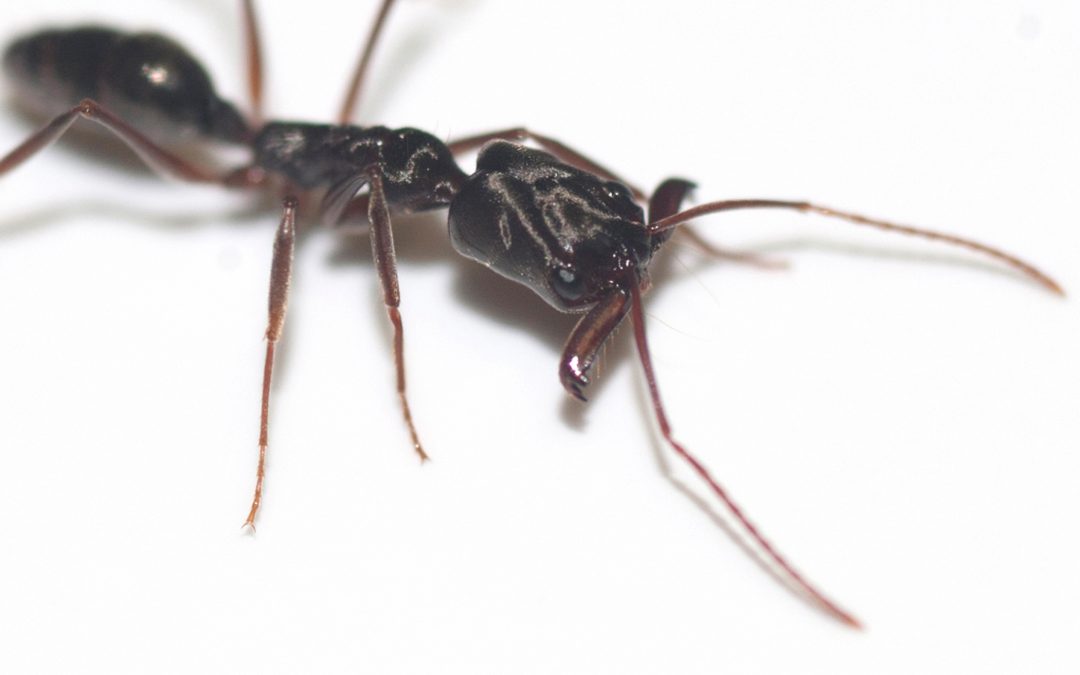
by Beth Bolles | Apr 16, 2019
One of the interesting ants that I am seeing more commonly in landscape settings is the Trap jaw ant (Odontomachus sp.). This ant is so named because of it’s large mandibles (mouthparts) that spring shut capturing prey. These mouthparts can also be used as a defensive mechanism allowing the ant to spring away from something it encounters.
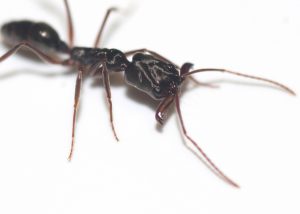
Trapjaw ants. Photo by MSU Ag Communications/Kat Lawrence
A nesting area is very recognizable after you have seen one because it looks like a collection of soil and small wood debris piled at the base of plants or old stumps. I have encountered nesting areas around living shrubs in many mulched areas of the landscape and under pots sitting on old tree stumps.

Nesting debris from the Trapjaw ants at the base of a Princess flower. Photo by Beth Bolles, UF / IFAS Extension Escambia County.
My first experience with the trap jaw ant was not very pleasant. I was working in a mulched area pulling a few weeds without gloves. I unknowingly disturbed the nest and received a pain sting similar to a paper wasp sting. The discomfort was short-lived and I personally did not have inflammation or inching a few minutes later. Of course, I identified the ant and have since become very familiar with recognizing nesting spots.
Although trap jaw ants are not native to our area, they do not rank in the same category as fire ants which are both economically and medically problematic. Since trap jaw ants are currently found in more natural areas of the landscape, homeowners should just be aware of their presence. Consider a pair of gloves or garden tools when rooting around in mulch. When a nesting area is disturbed, the large ants (about .5 inches) will be easy to observe as one of the more interesting ants we may encounter.

by Beth Bolles | Feb 5, 2019
Are you a patient gardener? If not, try you hand at growing microgreens. Why wait for at least a month or so for a harvest when you can enjoy fresh greens in as little as 7 days.
Microgreens are the tender seedlings of your favorite vegetable or herb. They are grown in containers or flats and harvested when the first seed leaves are fully emerged. You may also wait until you see the first true leaf. Unlike sprouts, microgreens require light and are cut when harvesting to only include the stem and leaves. Depending on the seeds you start, you may enjoy mild or spicy greens, or refreshing lemony flavors of a young herb.
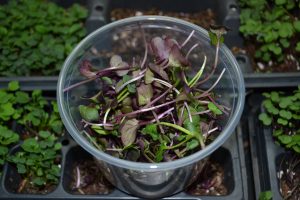
Microgreens can offer beautiful colors for your dish. Photo by Beth Bolles, UF IFAS Extension Escambia County.
Here are the basic steps to get started growing microgreens.
- Get a commercial tray or recycled container and sterilize it in a 10% bleach solution. Make sure your recycled containers have drainage holes.
- Choose a good seed starting potting mix that is more fine textured. Many seeds you will start are small and a mix with a lot of bark may affect seedling germination. Add one to 1.5 inches of the soil in your container. You don’t need more depth of soil since you will be harvesting in a week to 20 days.
- Decide which types of greens you like. Consider arugula, radish, mizuna, or mustard for some spice. Swiss chard and purple cabbage will give you color, while collards, broccoli, and kale will offer mild flavors. Don’t forget about herbs like dill, cilantro, or basil for good flavors too.
- Once you have chosen your seed, beginners should seed one selection per container. As you learn the growth rate of your favorite selection, you may can combine different varieties in a flat.
- Make sure your soil is moistened (but not soaking) and spread seed on top of the soil. You will be adding about 12 seeds per square inch of soil for small seeds and about 7 seeds per square inch for larger seeds.
- Sprinkle vermiculite over the seeds and then use a spray bottle or nozzle mister to moisten the vermiculite.
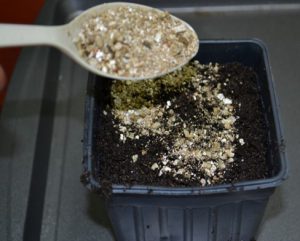
Vermiculite allows moisture to get to seeds and may reduce seedling disease pressures. Photo by Beth Bolles, UF IFAS Extension Escambia County
- Place containers in a greenhouse, window sill, or indoor growing tray. As soon as the seeds germinate, make sure they are receiving bright light. If growing indoors, the fluorescent or plant lights need to be a few inches above seedlings. Move the lights higher as your seedlings grow.

New seedlings need bright light. Indoor lights that are 2-3 inches from seedlings prevent thin, spindly stems. Photo by Beth Bolles, UF IFAS Extension Escambia County
- Maintain a room temperature of about 70 degrees F. Temperatures above 75 degrees F can lead to disease issues
- It is also best to water from the bottom to prevent disease issues. If this is not possible, carefully water seedlings so not to injure delicate plants.
- Radish and kale will be ready for harvest in about 7 days. Swiss chard, basils, and cilantro may take 20 days.
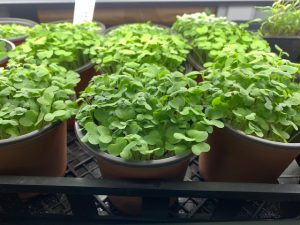
Microgreens are ready to harvest. Photo by Beth Bolles, UF IFAS Extension Escambia County
- Use clean scissors to cut stems, careful not to pull up any soil. Remaining soil and roots can be composted.
- When you are ready to use in a salad, sandwich or in juicing, place microgreens in a bowl of water to wash. Let them air dry on a paper towel.
The good news about growing microgreens, is if you find they are not to your liking or too much trouble, you it has only been a couple of weeks of effort.
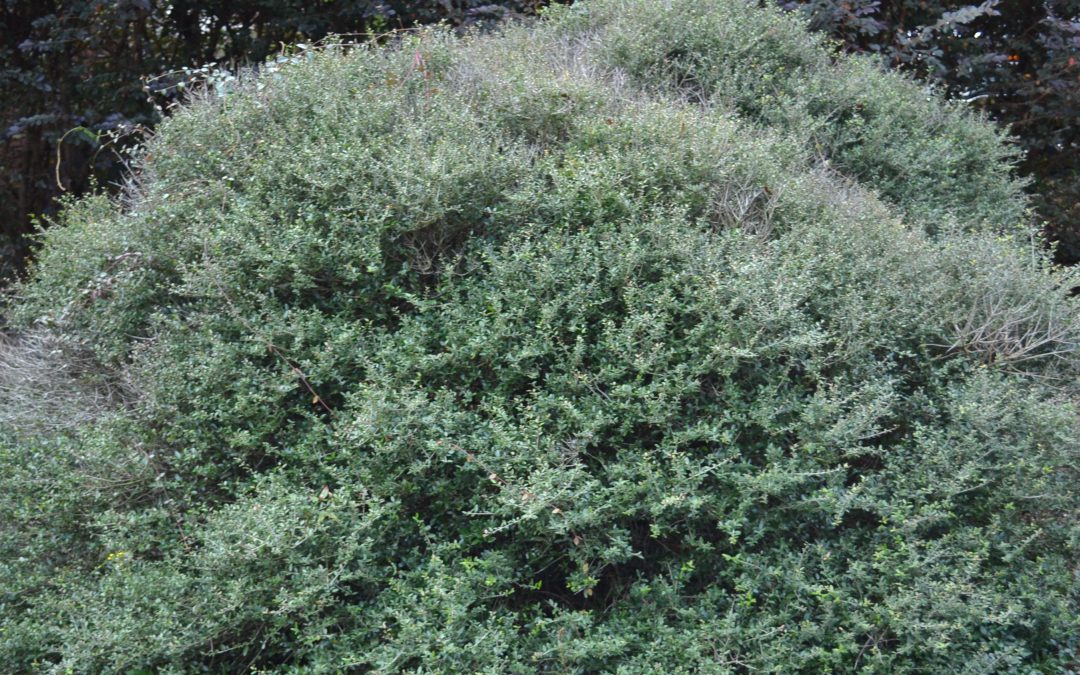
by Beth Bolles | Jan 3, 2019
Shrubs can serve many purposes in a landscape and have been used in both mass plantings and as accent features. They can include plants that offer colorful blooms, food for pollinators, and screens for less than favorable views.
We tend to think that shrubs will be permanent feature in our landscapes, because many are hardy and adapted to our climate. Like any other plant you may choose for your yard, shrubs may not live forever and there are a wide variety of reasons a shrub may need replacement after years of solid performance.
Let’s use any example from my own yard of the Dwarf yaupon holly, Ilex vomitoria ‘Nana.’ Back in 2001, I planted three hollies, spaced with plenty of room to grow, in a border area of my landscape. The plants grew well forming mounds about 3.5 feet high and 4 feet wide. Since the ‘Nana’ holly is a naturally mounding shrub, it did not require pruning and once established, rainfall supplied needed water.
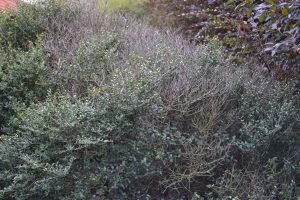
Yaupon holly with dieback after 17 years in a landscape. Photo by Beth Bolles, UF IFAS Extension Escambia County
Over the past year, several areas of branch dieback have developed in all plants. After finally deciding that the dieback was unattractive enough to warrant plant removal, I began cutting the plants back. I discovered dead interior branches, girdling roots, and some internal stem discoloration. In other words, there are many factors that have led to poor plant performance. Another issue is a large Loropetalum hedge (planted by my neighbor) that shades one side of the plant.
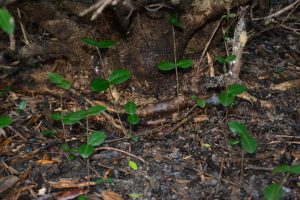
Girdling roots often develop when rootballs have not been properly prepared during installation. Photo by Beth Bolles, UF IFAS Extension Escambia County
What could I have done to help these plants stay healthier for many more years? I could have prepared the rootball better for planting by shaving off the edges or supplied a little fertilizer on occasion in my sandy soil. These practices may have extended the life of the plants for several more years, but they may not have made a difference. Sometimes shrubs decline and die. I am accepting that not everything performs at an outstanding level in our climate. Also, there is an end point for some of my favorite plants in the yard. Some may outlive me while others thrive for a few years or a decade or so.
The bright side of loss of my Yaupon hollies is that I get to plan for a feature for the new year. Maybe something for pollinators and birds to last the next 17 years.
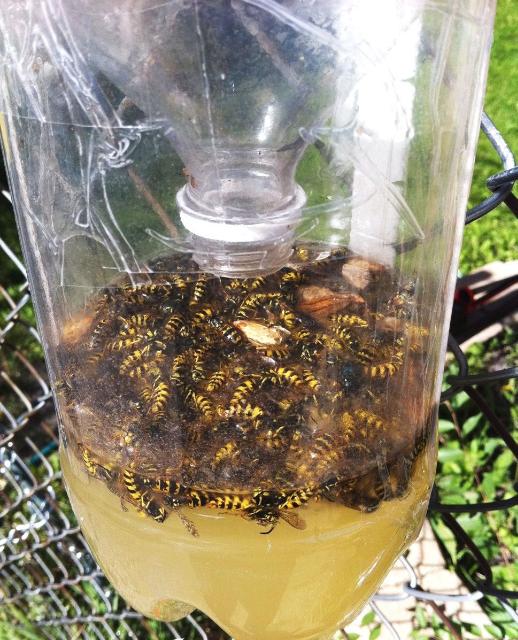
by Beth Bolles | Oct 29, 2018
As Hurricane Michael was barreling through the Panhandle region, wasp populations were at their highest of the year. Winds and flooding destroyed many of the nests of paper wasps, hornets, and yellow jackets and now wasps may be aggressive as they defend themselves or remnants of their nests. All are capable of multiple stings that are very painful. It is very likely that you will encounter stinging wasps as they scavenge for food and water, as well as seek shelter among debris and exposed trash.
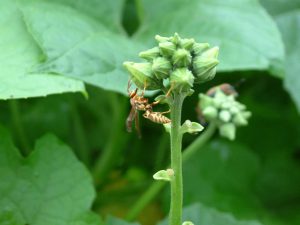
Many people are stung by paper wasps after storms. They are not attracted to traps.
Here are a few pointers to help deal with stinging wasps.
- Try not to swat at wasps flying around or landing on you. You may be less likely to receive a sting if you can flick them off.
- Some wasps are attracted to the sap from broken or recently cut trees. Look before you reach. Wear gloves and other protective clothing when moving debris in case you disturb foraging or nesting activities.
- Wasps are also attracted to sugars and water. Try your best to keep food and drink cans covered. Completely close garbage containers or bags that contain food debris.
- Repellents are not effective against wasps. There are pesticides labeled to spray on smaller paper wasp nests if you find one in a spot close to people’s activity. These are usually aerosol pyrethroids or pyrethrins. Make sure you read the label carefully and use the product as directed.
- Do not use non labeled products like gasoline to manage wasps. This is not only illegal but can be dangerous to yourself and the environment.
- There are traps for yellowjackets that you may purchase or make. These only manage those wasps flying around, not any remaining in a ground nest.
Here is a Do It Yourself Yellowjacket trap from UF IFAS Extension.
- Cut the top 1/3 off your 2 liter bottle so that you have 2 pieces.
- Add a bait (fermenting fruit or beer) to the bottom of the plastic bottle.
- Invert the top portion of the bottle into the base, forming a funnel.
- Hang or place traps so they are about 4 to 5 feet above the ground. For safety, place them away from people.
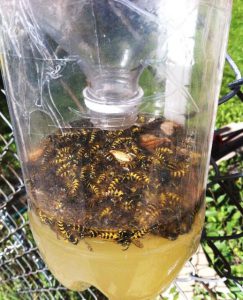
A homemade trap to catch yellowjackets. Photo by Alison Zulyniak
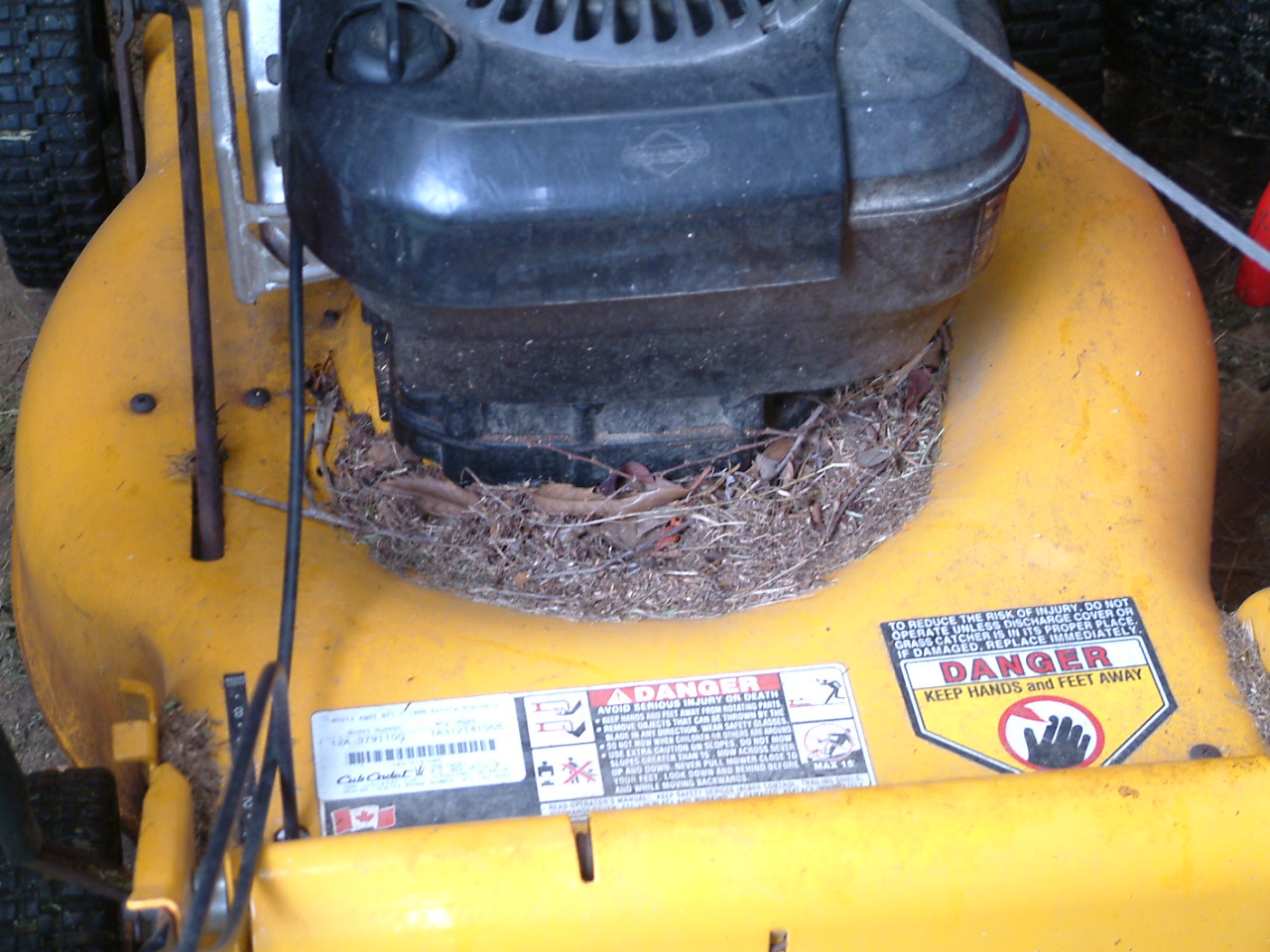
by Beth Bolles | Sep 18, 2018
Just when you think your battle against weeds is over for the summer, cooler nighttime temperatures and shorter days spark the beginning of a new crop of your least favorite plants. The question of many homeowners is how did all the weeds get to my landscape?
There are many ways that weeds make it to the landscape. They can be brought in with new soil, mulch, container plants, dropped by birds, delivered on the fur of animals, carried by wind, or on the deck of a lawn mower. If that is not enough to depress you than also realize that regardless of outside sources of weeds, your landscape already has plenty onsite that you don’t even know about.
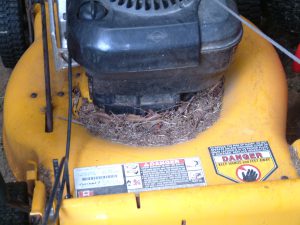
The deck of a lawn mower can collect plant debris, including seeds, that are spread through the landscape. Photo by Beth Bolles, UF IFAS Extension Escambia County.
In the soil, there is a large number of weed seeds ready to germinate when the conditions are just right. Understanding how your common landscape practices can encourage or discourage the germination of these seeds, can help you begin to manage some weed infestations.
Many of the seeds of common annual weeds are very small. They require exposure to sunlight in addition to the proper temperatures and moisture to germinate. Sunlight is critical though and seeds will not germinate without adequate sunlight. If the small seeds are deep in the soil, you will probably never know they are there. When you turn soil or disturb soil such as when installing plants, you bring the small seeds close to the surface and closer to light. They can then be stimulated to germinate. The next thing you know is that you have an area covered in weed seedlings.
What does this mean for your gardening practices? Try your best to block sunlight from hitting exposed soil. You can do this by keeping a healthy turf, free of thinning spaces. A 2-3 inch layer of mulch in plant beds and vegetable gardens will reduce weed seed germination. Finally when you are installing plants in an established bed, try not to mix soil with surrounding mulch. Seeds will easily germinate within the mulch if it becomes mixed with soil.
It is inevitable that your landscape will have some weeds but a few easy gardening practices can reduce some of your weed frustrations.
















